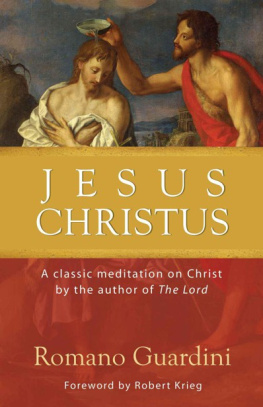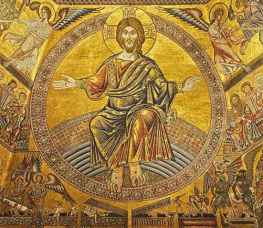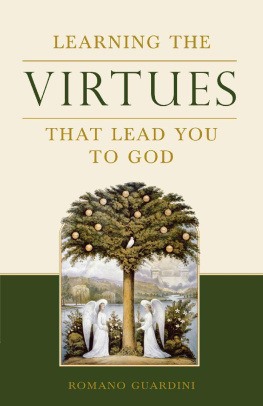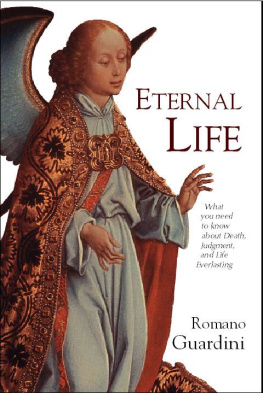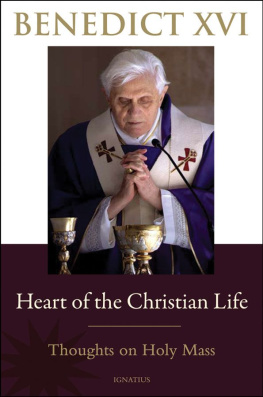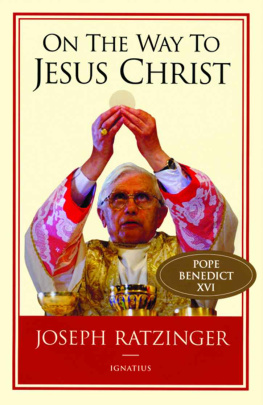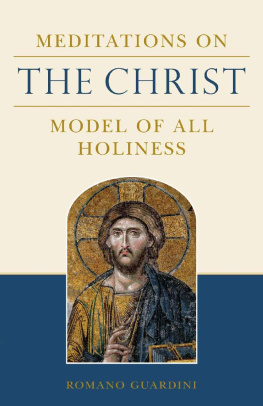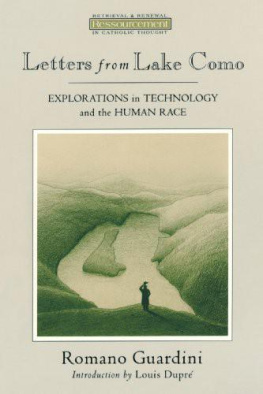Table of Contents

Except for a few places where the older translations are more appropriate, the biblical quotations used in this translation are from Msgr. Ronald Knoxs translation of the New Testament (Sheed and Ward: New York, 1944).
Nihil obstat:
J. Gerard Kealy, D.D.
Censor theol. deput.
Imprimatur:
Albert Gregory Meyer, S.T.D., S.S.L.
Archbishop of Chicago
June 15, 1959
First published in Germany under the title Jesus Christus, Geistliches Wort by Werkbund-Verlag Wrzburg 1957. First published in the United States by Henry Regnery Company, 1959.
____________________________________
2012 by Ave Maria Press, Inc.
All rights reserved. No part of this book may be used or reproduced in any manner whatsoever except in the case of reprints in the context of reviews, without written permission from Christian Classics, Ave Maria Press, Inc., P.O. Box 428, Notre Dame, IN 46556.
Founded in 1865, Ave Maria Press is a ministry of the United States Province of Holy Cross.
www.christian-classics.com
Paperback: ISBN-10 0-87061-257-3 ISBN-13 978-0-87061-257-2
E-book: ISBN-10 0-87061-269-7 ISBN-13 978-0-87061-269-5
Cover image: Baptism of Christ by Alessandro Allori, photo credit Scala/Art Resource, NY.
Cover and text design by John R. Carson.
Printed and bound in the United States of America.
Library of Congress Cataloging-in-Publication Data
Guardini, Romano, 1885-1968.
[Jesus Christus, geistliches Wort. English]
Jesus Christus / Romano Guardini.
p. cm.
ISBN-13: 978-0-87061-257-2 (pbk.)
ISBN-10: 0-87061-257-3 (pbk.)
1. Catholic Church--Sermons. 2. Sermons, German. I. Title.
BX1756.G85J43 2011
232--dc23
2011045443
Foreword
An Introduction to Jesus Christus
THE FOCAL POINT of the Christian faith is Jesus Christ, the divine Word who became flesh (Jn 1:14). Two millennia ago, the Lord Jesus proclaimed the coming of Gods reign through his words, deeds, and very person. Rejected by the religious and civil authorities in Jerusalem, he suffered and died on a cross, but rose from the dead to eternal life. Now, alive in the Holy Spirit, Christ remains invisibly present to us, and he will return in glory with Gods new heaven and a new earth (Rv 21:1). At Mass, we acknowledge this mystery of faith when we declare: We proclaim your Death, O Lord, and profess your Resurrection until you come again.
This sacred mystery is the focal point of Jesus Christus (first published in 1957). This book was meant by its author Romano Guardini (d. 1968) to challenge our ignorance concerning who Jesus is so that we will attain a fresh impression of the figure of Christ (pp. 4950). Toward this aim, it consists of thirteen meditations concerning Gods mystery, that is, Christ himself, in whom are hidden all the treasures of wisdom and knowledge (Col 2:23).
Romano Guardinis numerous books and articles have shaped the lives of Catholics around the world for almost one hundred years. His Spirit of the Liturgy (1918) became a bestseller in at least six languages and eventually bore fruit in the Second Vatican Councils Constitution on the Sacred Liturgy, Sacrosanctum Concilium (1963). Pope Paul VI prized Guardinis texts and in 1965 invited Guardini to become a cardinal, an invitation which the theologian graciously declined. As a student and a priest, Pope John Paul II drew on Guardinis insights into the character of personal existence in modern society. Today, Pope Benedict XVI frequently quotes Guardini. Indeed, he refers to the theologians Christology in his Jesus of Nazareth: Part Two (2011). Further, the theologians Karl Rahner and Hans Urs von Balthasar studied with Guardini and subsequently made use of his ideas in their respective writings.
Guardini also influenced American Catholicism. Dorothy Day frequently cited Guardinis writings in her newspaper The Catholic Worker , and Flannery OConnor said she tried to read everything I can of Romano Guardini. Thomas Merton read Guardinis books from the 1950s until his tragic death in 1968. When the theologian Monika Hellwig was a student, she was inspired by Guardinis The Lord (1937) and mirrored this book in her Jesus: The Compassion of God (1983).
Who was Romano Guardini? He was a priest-theologian with a twofold aspiration: (1) to retrieve the truths of divine revelation in the Churchs scripture and tradition, and (2) to express these truths anew in relation to the contemporary worlds images, ideas, and categories.
Born in 1885 in Verona, Italy, Guardini grew up in Mainz, Germany. In 1910, he was ordained a priest of the Diocese of Mainz. He earned his first doctorate in 1915 and his second in 1922. During the 1920s and 1930s, Guardini taught theology at the University of Berlin and was simultaneously the national leader of Germanys Catholic youth association, Quickborn. In 1939, he withdrew from both roles, as demanded by Nazi officials. After the Second World War, he taught at the University of Tbingen (19451948) and then at the University of Munich (194863). Guardini died at the age of eighty-three. He is now buried in Munichs Saint Ludwig Church where he preached on Sundays for more than two decades.
As intended by Guardini, Jesus Christus unites a biblical view of the Lord Jesus and a contemporary account of being a person. On the one hand, the book elucidates the portrait of Jesus Christ in St. Johns Gospel. Proceeding from the Father, the Son assumed a human nature, being born of the Blessed Mother. During his earthly life, Jesus Christ passed among us, revealing Gods love for all people and saving us by paying the price for our sins. After his death, Christ returned in glory to the Father and sent the Spirit among us.
On the other hand, Jesus Christus employs a notion of person developed by Guardini out of the writings of Max Scheler, Rainer Maria Rilke, and Martin Heidegger. To be a person is to be a unique subject, an I. As such, every person is an irreducible reality, a mystery whom we can increasingly understand but never fully fathom. Further, Jesus Christ is the divine person in relation to whom human beings receive the strength and guidance in the Holy Spirit to become the persons whom God envisions each of us to be.
As stated earlier, the explicit goal of Guardinis meditations in Jesus Christus is to lead each reader to a greater knowledge of and union with the Lord. At the same time, the books implicit goal is each readers maturation into the person whom God envisions.
A shortcoming of Jesus Christus is that it reads the Gospels of St. Matthew, St. Mark, and St. Luke through the lens of St. Johns Gospel. It is too one-sided in its claim that [t]he writers of the Synoptic Gospels looked deeply into Jesus. But the ultimate revelation was made only by John (p. 82). As Vatican II teaches in its Dogmatic Constitution on Divine Revelation, Dei Verbum (1965), each of the Gospels offers its own invaluable insights into the mystery of Jesus Christ (n. 18).
This limitation notwithstanding, Jesus Christus remains a Christian classic. It calls into question some ideas concerning Christ and sheds fresh light on Gods incarnate Word. Thus, this book facilitates our reflections on scripture and tradition which, according to Dei Verbum (n. 7), are like a mirror, in which the Church, during its pilgrim journey here on earth, contemplates God, from whom it receives everything, until such time as it is brought to see God face to face as he really is (see Jn 3:2).
Robert Krieg
His Mother
Blessed art thou that hast believed!
(Luke 1:45)
TO ATTAIN a full understanding of a tree as it is, we must look into the earth where its roots are, from where the sap arises into the trunk, twig, blossoms, and fruit. Similarly, we shall do well to consider now that earth from which the personage of Our Lord arisesMary, His mother.
Next page
